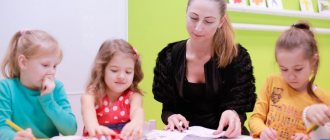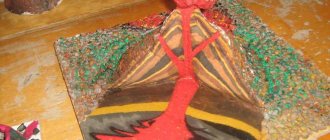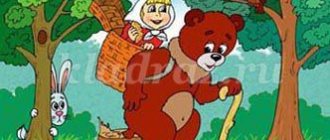Open vocal lesson theme “Rhythm”
PLAN – LESSON SUMMARY
Oksana Anatolyevna Grigorieva, additional education teacher, head of the vocal studio “Maximum” of the Children’s Creativity Center, Atkarsk, Saratov Region. Open lesson of a vocal club for 1-3 years of study, topic: “Rhythm”
Lesson topic: “Rhythm”
Purpose of the lesson:
creating a joyful, friendly atmosphere of the lesson, which promotes successful acquaintance with the elements of musical notation: scale, rhythm.
Lesson objectives:
- develop creative abilities by involving children in the emotional performance of chants, songs, and playing musical instruments;
- develop singing skills in the process of vocal and choral work;
- to form a sustainable interest in musical culture;
- cultivate patriotism and good relations with each other and with others.
Preliminary work.
- Learning tongue twisters, breathing exercises, diction, sound production.
- Individual work with children on learning songs and chants.
- Listening to music r.n.p. "Kamarinskaya".
Motivation:
The teacher asks the students to return the notes.
Hall decoration:
on the wall there is an image of a treble clef and a staff with notes; "Musical Caterpillar"
Equipment:
handouts, audio recordings, tape recorder, sheet music, percussion instruments (spoons, drum).
Hearing:
song “Do, re, mi” by the group “Domisolka” lyrics. V. Klyuchnikova,
music O. Yudakhina., “Song about a song”, “Russia”, r.n.p. "Kamarinskaya".
During the classes.
- Organizing time.
Formation in front of the hall.
Entrance with music:
The song “Do, Re, Mi” is playing.
Musical greeting
: “Domisolka” lyrics. In Klyuchnikova,
music O. Yudakhina.
- Introductory speech by the teacher.
I am very glad to meet you again.
The world of music is mysterious and amazing. This kingdom of sounds can only be understood by those who know how to hear and listen, to see the unusual in ordinary things, who love to dream and fantasize, who strive for knowledge and are hardworking. In this world, it is customary to express yourself in a special language - musical, which you guys have to master.
What does a composer need to know to record music or a performer to perform it? (Sheet music, musical notation).
Today in class, with the help of music, we will try to create a joyful, friendly atmosphere and get acquainted with the elements of musical notation.
We are going to the country of Music, where our friends are already waiting for us - Cheerful notes. And notes are written on rulers.
Five lines of musical notes
We called it "staff".
And all the notes on it are dots
We took our places.
Guys, look at the staff. Just this morning there were notes there, but suddenly they disappeared. We definitely need to get them back. Well then, let's go.
- Work on the topic of the lesson.
Guys, what can you travel with?
- Voice exercises (“Donkey”, “Airplane”, “Train”).
One note wants to return to its house. Before
We warmed up our vocal cords and reached the land of Music, where everyone sings.
You and I will sing too.
Review the rules of singing
(ask the children)
If you want to sit and sing
Don't sit down like a bear
Straighten your back quickly
Put your feet on the floor, be bold
- Chanting
"From the clatter of hooves"
- work on diction and dynamics:
- Clear diction;
- Strokes
- Working on dynamics;
- “Do, re, mi, fa, sol” lyrics. Z. Petrova, music. A. Ostrovsky
- Working on breathing;
- Construction of a triad
- Singing by hand
Well done, you did a good job with this task and returned the note D.
The note is attached to the staff.
What's your mood? Does music have a mood? Let's wish everyone: Good mood! And we will try to accurately convey the mood of this song “A Song about a Song”
. What is it like?
Performing the song “A Song about a Song”
(1, 2, 3 year old children)
The note is attached to the stave. Mi
Our journey continues. And now - a new task.
- Learning new material. Rhythm
1)
I will clap several times, and you will repeat what I show. Prepare your palms. Just listen carefully first. And you have to clap on my command and not loudly.
Examples of rhythmic dictations
1. "Kalinka"
2. “There was a birch tree in the field”
3. “Little Christmas tree”
writing a rhythmic pattern on the board
Did you notice that in every phrase that you repeated after me, clapping your hands, there were short and long sounds? The alternation of long and short sounds in music is called? rhythm.
Remember this new word. Repeat it.
The rhythm of a particular melody is a rhythmic pattern, i.e. element of rhythm. What durations does a rhythmic pattern consist of? (Quarter notes, Eighth notes, Sixteenth notes)
Duration
– duration of impact from impact to impact.
The rhythmic pattern consists of short and long durations
Rhythmic sounds are connected to each other, they can be even, smooth, or they can sound abrupt. Example:
The heart beats rhythmically, the clock ticks, the seasons change.
(example of children)
We come to the conclusion that order is created? (Even steps. Clear pattern. Uniform alternation of strikes.)
2) The task becomes more difficult.
Clap the rhythm: long sounds are hitting the knees, and short sounds are hitting the hands.
Any rhythm in music can be written with special notations. Today we will try to use signs and perform a rhythm.
3) Task “Musical caterpillar”
The board shows a caterpillar with large and small circles. Children clap rhythm.
4)
Exercise “Clock Choir”
Depending on the rhythm, the nature of the music changes. I suggest this exercise “Chorus of the Hours”
You need to depict the simultaneous movement of large and small clocks in a speech rhythmic two-voice. Group 1 says “bom-bom” in a low voice, and group 2 says “tiki-tiki” in a high voice.
The note is attached to the staff. F
No musical instruments emphasize the rhythm of the piece like percussion instruments. What percussion instruments do you know?
4) Playing music on musical instruments.
R.n.p. "Kamarinskaya"
What character? (perky, cheerful, mischievous)
What can be said about the melody (The melody changes and is repeated several times)
What instruments did you hear?
In Russian village dances there is not only a competition between dancers, but also a competition between instruments. The piece you listened to is called “Kamarinskaya”.
What used to be used for Russian dances?
So we will play music. instruments. First let's learn the rhythmic pattern.
performed by the teacher and students on percussion instruments “Kamarinskaya”.
They performed the piece wonderfully.
The note is attached to the staff. Salt
And now it’s time for us to take a walk through the fairytale forest.
- Physical exercise.
"Let's clap, stomp"
How wonderfully you moved,
And movement is health!
The note is attached to the staff. La
What a wonderful journey we have had through the musical kingdom-state. But the best country for any person is the one where he was born and raised, his Homeland. What is the name of the country where we live?
Performance of the song “Russia”
What is the mood of this song? What feelings does the author convey here?
The note is attached to the staff. Si
Guys, look at the staff.
Do, re, mi, fa, sol, la, si
These notes all form a scale.
So all the notes have returned home. Again we will sing and dance, play musical instruments.
- Bottom line.
Our journey has come to an end.
Who wants to share their impressions?
What elements of musical notation have we become familiar with? (rhythm, duration, scale).
Rhythm-
alternation of long and short sounds in music.
Duration
– duration of impact from impact to impact.
Scale
- this is a certain order of musical sounds that are used in music. Music staff with notes.
What interesting things did you learn? What do you remember most vividly? (We learned what rhythm is, played percussion instruments, sang as soloists, etc.).
VIII . Reflection.
Teacher:
I would like to know how you yourself evaluate your work.
Whoever thinks that he has done a good job, let him sing “A”,
and whoever thinks that not everything is working out yet
– “O”.
Children evaluate their work.
You can't part with music.
We've been in love with her since birth
And we won't tell her goodbye
Just: Goodbye!
They leave the class to the music.
Summary of a music lesson in kindergarten on vocal and choral work. Preparatory group
— Form a clear, clear singing diction;
— To foster an interest in singing in children. Lesson plan. 1. Children entering the hall 2. Musical greeting 3. Breathing exercises. 4. Articulation gymnastics. 5. Tongue twisters. 6. Vocal - intonation exercises. 7. Learning a song 8. Musical game 9. Farewell “Goodbye, music”
Children's entrance to the hall.
Musical greeting. We shake hands with each other, and with a smile, “Hello!” we sing. Good afternoon Good afternoon We are not too lazy to study - 2 rubles. The music director invites the children to come to the table, on it is a staff with beaded notes. M.R .: Guys, look!
Magnets hang on magic strings. Not ordinary magnets - they all sound. The necklace is glorious - it is a sheet music. I have it in store for you! These magnetic notes make up different songs. I’ll sing this song to you. M. r. takes the “notes” - they fall on the table.
M.R .: Oh! The beads scattered.
“Cloud and Rain” Spring will come soon, the snow will melt, it will rain. A cloud has rolled in (inhale), and it starts to rain (exhale, tapping the nostrils M-N)
After performing the breathing exercises, a sound is heard.
M.R .: This is one note that wants to return to its house.
M. r. attaches a note to the staff. And now, be quiet, let your tongue dance. Articulation gymnastics. Here is the tongue exercise: (Children perform movements according to the text of the game). The tongue turned to the right, to the left. on the side. Children stroking their cheeks with their tongues -
We open our mouths,
chat
the right and left perform the “Chatterer” exercise.
And now, friends, no joke, let’s brush our teeth with our tongue.
They pass the tongue several times over
Let's Smile to All Friends,
the upper teeth, then along the lower teeth,
you can't sing without smiling.
They smile, stretching their lips wide.
After performing articulatory gymnastics, a sound is heard.
M.R .: This is one note that wants to return to its house. M. r .
attaches a note to the staff. Speaking tongue twisters is not an easy task. We will say it beautifully, clearly and skillfully.
Tongue Twisters.
The little mouse was composing tongue twisters in his hole before morning. It turned out to be exactly forty. He has tongue twisters.
After the tongue twister is performed, a sound is heard.
M.R.: This one bead wants to return to its house. M. r. attaches one bead to the staff. If you want to sing loudly, don’t sit down like a bear, put your feet on the floor harder, straighten your back quickly. Arms and shoulders are all free. Singing is pleasant and comfortable.
Vocal - intonation exercises.
“Snowflakes are falling, white fluffs. Put your palm up, wait a little.”
“1,2,3,4,5, Go out for a walk quickly, We’ll go down the ice slide, We’ll ride in a crowd.”
“We dropped the bear on the floor, tore off the bear’s paw, I still won’t leave him, because he’s good.”
“The giraffe grows tallest, it reaches the sky”
“An elephant is as huge as a house, go around it, and you will see that it is not easy to climb onto a house of such height.”
After performing vocal and intonation exercises, a sound is heard.
M.R.: This one bead wants to return to its house. M. r. attaches five beads to the staff.
The song comes to visit us and brings joy to us all.
Video of the song “Gingerbread House”
Learning the song 1. Read the text to the rhythm of the song 2. Sing 1 verse of the song 3. Learn the verse of the song.
4. Sing 1 verse and chorus. After the song is played, a sound is heard.
M.R.: These beads want to return to their house. M. r. attaches five beads to the staff.
Music game
"Heel, toe"
After the game is played, a sound is heard.
M.R. _ These beads want to return to their house. M. r .
attaches five beads to the staff. M.R .: So all the beads have returned home.
It is difficult for us to sing and dance without music. We put the beads in a music book. Again all the friends are happy about the wonderful music And we can no longer lose those beads.
M.R .: Thank you guys for coming to me, making me happy, and what you remember and what you liked, I was very pleased swami, and I want to convey to you from the gnomes of their gingerbread house a ringing candy cockerel. Gives PETUSHKOV.




